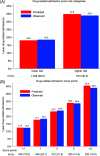Predictors of 1-year drug-related admissions in older multimorbid hospitalized adults
- PMID: 35064571
- PMCID: PMC9305949
- DOI: 10.1111/jgs.17667
Predictors of 1-year drug-related admissions in older multimorbid hospitalized adults
Abstract
Background: Identifying patients at high risk of drug-related hospital admission (DRA) may help to efficiently target preventive interventions. We developed a score to predict DRAs in older patients with multimorbidity and polypharmacy.
Methods: We used participants from the multicenter European OPERAM trial ("Optimising PharmacothERapy in the Mutlimorbid Elderly"). We assessed the association between easily identifiable predictors and 1-year DRAs by univariable logistic regression. Variables with p-value< 0.20 were taken forward to backward regression. We retained all variables with p < 0.05 in the model. We assessed the C-statistic, calibration (observed/predicted proportions), and overall accuracy (scaled Brier score, <0.25 indicating a useful model) of the score, and internally validated it by tenfold cross-validation.
Results: Within 1 year, 435/1879 (23.2%) patients (mean age 79.4 years) had a DRA. The score included seven variables: previous hospitalizations, non-elective admission, hypertension, cirrhosis with portal hypertension, chronic kidney disease, diuretic, oral corticosteroid. The C-statistic was 0.64 (95% CI 0.61-0.67). Patients with <1 point had a 12.4% predicted and observed risk of DRA, while those with >3 points had a 40.4% predicted and 38.9% observed risk of DRA. The scaled Brier score was 0.05. Calibration showed an adequate match between predicted and observed proportions.
Conclusion: Comorbidities related to drug metabolism, specific medications, non-elective admission, and a history of hospitalization, were associated with a higher risk of DRA. Awareness of these associations and the score we developed may help identify patients most likely to benefit from preventive interventions.
Keywords: drug-related admission; older adult; readmission; score.
© 2022 The Authors. Journal of the American Geriatrics Society published by Wiley Periodicals LLC on behalf of The American Geriatrics Society.
Conflict of interest statement
The author declares that there is no conflict of interest that could be perceived as prejudicing the impartiality of the research reported.
Figures

References
-
- Hughes LD, McMurdo ME, Guthrie B. Guidelines for people not for diseases: the challenges of applying UKclinical guidelines to people with multimorbidity. Age Ageing. 2013;42:62‐69. - PubMed
-
- Leendertse AJ, Egberts AC, Stoker LJ, van den Bemt PM. Frequency of and risk factors for preventable medication‐related hospital admissions in The Netherlands. Arch Intern Med. 2008;168:1890‐1896. - PubMed
-
- Aubert CE, Streit S, Da Costa BR, et al. Polypharmacy and specific comorbidities in university primary care settings. Eur J Intern Med. 2016;35:35‐42. - PubMed
-
- Field TS, Gurwitz JH, Avorn J, et al. Risk factors for adverse drug events among nursing home residents. Arch Intern Med. 2001;161:1629‐1634. - PubMed
-
- Krähenbühl‐Melcher A, Schlienger R, Lampert M, Haschke M, Drewe J, Krähenbühl S. Drug‐related problems in hospitals: a review of the recent literature. Drug Saf. 2007;30:379‐407. - PubMed
Publication types
MeSH terms
Grants and funding
- 6342388/Horizon 2020 Framework Programme
- 320030_188549/Schweizerischer Nationalfonds zur Forderung der Wissenschaftlichen Forschung
- P2LAP3_184042/Schweizerischer Nationalfonds zur Forderung der Wissenschaftlichen Forschung
- 15.0137/Swiss State Secretariat for Education, Research and Innovation (SERI)
- SNSF_/Swiss National Science Foundation/Switzerland

